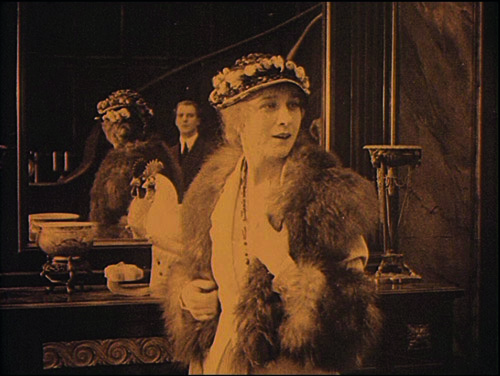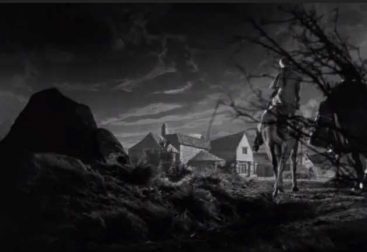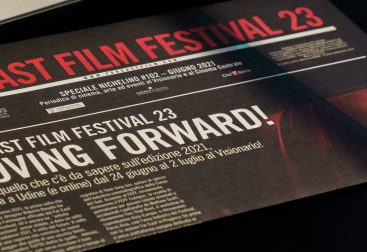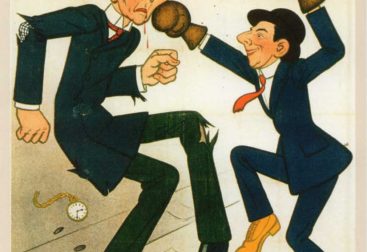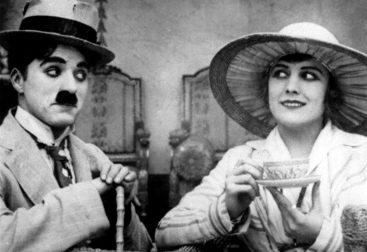Saturday 29 January – Fourth day of the festival
First program: Fabulous Lola (OT: Die tolle Lola)
Today we start at 3 p.m. with Richard Eichberg’s film “Fabulous Lola” (OT: Die Tolle Lola) with Lilian Harvey.
In the festival program, the film is the example of German light comedy of the 1920s. A critic of the premiere rightly remarked that Richard Eichberg is not a director of Ernst Lubitsch’s caliber. Difficult comedies with depth were not his métier. Of course Lilian Harvey is fun to watch. And Kristina Köhler presents all of this well in her very succeeded video introduction.
At the suggestion of Maria Adorno, we have included video introductions in the program. I was a bit concerned about whether it would be well received by our audience. My concerns turn out to be unfounded. The video introductions, timed to around five minutes, are all well received.
The plot is incredibly simple. Lilian Harvey is allowed to develop all her acting talents as a fiery Spaniard on the one hand and as a good bourgeois daughter on the other hand and to turn some men’s heads. In the end they get married. All in all a very entertaining film. You shouldn’t expect more from Richard Eichberg. Again a very successful musical accompaniment by Richard Siedhoff
Now, one more objection: In retrospect, this film – and perhaps also the entire German light comedy of the second half of the 1920s – seems to me as if the light, two-act comedy of the 1910s had been stretched out to five acts. But what was treated briskly and lively in two acts is now being dragged out without giving the plot a little more humor and depth. And so, I can’t put it much differently, these comedies tend to be a bit long or boring for me and occasionally, because a lot is very foreseeable, also long-winded. However, “The Fabolous Lola” remains consistently very good entertainment. But see my commentary on “Comtesse Doddy” with Pola Negri (program: comedies from the collection of the EYE Institute, Amsterdam)
Second program:
Film Concert: “Erotikon”
For me one of the key films of the festival. I know that not everyone appreciates this film, but that seems to be the destiny of a difficult comedy, a “sophisticated comedy”, although I don’t think that necessarily means “difficult”, but rather with a polished plot, difficult to fathom characters and complicated intrigue.
Here, an aging entomologist is married to a spoiled, elegant young woman who has several suitors. And someone who seems serious accuses the young woman of adultery with a less scrupulous lover (?). I put the question mark because the viewer is left in the dark for a long time as to whether the professor’s wife actually committed adultery with that second suitor or not. The first admirer tells the professor exactly that – with almost fatal consequences …. But wait, that’s saying too much about the content.
Unfortunately, there were and still are a number of critics and interpreters who don’t recognize the film’s full sophistication. Some write that the professorial husband is not involved at all. Well, at the end of the film we see him remarried, with the housekeeper who at least knew his culinary preferences very well. And the dramaturgical function of the visit to the ballet, roughly in the middle of the film, is also not recognized by many: the “worst case” of adultery is presented.
Mauritz Stiller also has the formal means and can use them perfectly to show the viewer the emotional reactions of everyone involved in a scene at the same time. An excellent example is the mirror scene that we use as the cover of this second part of the diary. We not only see the admirer (Lars Hanson) with his somewhat confused look, we also see the reaction of the young woman and feel the tension between the two people, which is expressed in the body language.
As already mentioned several times: one or the favorite film by Ernst Lubitsch.
Music: The Trio “Transformer”, which can shape the film concert this year, accompanies the film with modern music that helps the film dramaturgically and thus maintains the aesthetic level of the film. That’s not easy with this film, and I would like to give the ensemble with Sabine Zimmer on the piano, with Chun Lin (cello) and Klaus Roth on drums special praise for the music.
Third program: German comedies from the collection of the EYE Institute Amsterdam.
The Eye Institute, the film archive and film museum of the Netherlands, has a unique collection of Early Cinema’s films, centered on the Desmet Collection, which is a UNESCO World Heritage Site.
Many German films have only survived in the Netherlands and are now part of the film collection of the EYE Institute. It made sense to curate a program with films from this collection and at the same time to pay tribute to this collection.
We would have liked to have included “The Pink Slipper” (OT: Das Rosa Pantöffelchen) by Franz Hofer with Dorrit Weixler in the program, but unfortunately this was not possible for various reasons. We then decided on three films.
A cheap bathing trip (OT: Eine billige Badereise)
Appearances are deceptive (OT: Der Schein trügt)
Comtesse Doddy
“A cheap bathing trip” is mainly worth seeing because of the young Henny Porten. The lively and convincing screen presence with which she acts is amazing. The film itself isn’t exactly a masterpiece, but it’s short and enjoyable.
“Appearances are Deceptive”, for which Gustav Trautschold wrote the script and probably also directed (this cannot be verified by the available sources) is again a light two-act comedy like “The Checkered Raincoat”. And another comedy of mistaken identity: a young married couple wants to go to the opera; the husband accidentally puts the ash from his cigar on his shirt, he goes back into the house and catches the maid trying on his wife’s clothes. Because her husband doesn’t come back right away, she goes into the house and catches her husband, who has ordered the maid to quickly take off his wife’s dress. Already we’re in a right mess, uh, that is a the marital quarrel. Luckily, the man has a bright idea how to fix the mishap.
Dramatized briskly and without much fuss or retardation, we have a very entertaining film in front of us. The public sees it that way too and enjoys the very nice copy.

The original poster is in the “Deutsches Filmmuseum” in Frankfurt;
the photo comes from filmportal.de.
“Comtesse Doddy” on the other hand is a disappointment. According to the description, one could assume a mix of adventure or sensational film and comedy. But the adventures of the bridegroom, whose arrival is impatiently awaited, in Africa are not shown, which would be possible in the film, but only told in the style of the messenger report known from the theater.
The production obviously simply didn’t have the money to build a reasonably credible African-style decoration in the studio. The plot remains trivial and transparent; Pola Negri is hardly lead as an actress and acts as we know her: spirited, but little challenged.
Fortunately, the duo Richard Siedhoff and Mykyta Sierov accompanied the three films with such energetic music, which also helped the individual films a lot (and made “Comtesse Doddy” bearable despite all its shortcomings), so that the event became a wonderful experience.
Sunday 30th January – Fifth day of the festival
Sunday matinee
His Wife The Unknown
This film faces a lot of resistance to its interpretation. Already at the premiere, the opinions of the critics were divided; if some were enthusiastic, others rejected him brusquely.
However, another film by director Benjamin Christensen, which was released in German cinemas just a few weeks before “His Wife, The Unknown”, posed even more puzzles to the public. It was “Häxan” (Witches).
While “Häxan” can be considered more as an experimental film, Benjamin Christensen himself described “His Wife, The Unknown” along with several other films as commercial commissioned work, which, so to speak, lowers our horizon of expectations a little, if one may say so briskly.
As a viewer, one is at least irritated by the change of genre over the course of the film; it begins melodramatically, then finally there is a change to comedy, which is also very clearly carried out. If the melodrama according to Thomas Elsaesser is characterized by the concealment of the actual conflict, here the deeper conflict is precisely named and precisely because of this there is a change of genre. Incidentally, the scene can be localized very precisely in the film.
If, following the laws of melodrama, the viewer initially had to reckon with the fact that there would be a very bad ending, now the conflicts can suddenly all be resolved and one laughs a little.
And then Benjamin Christensen still relied on a few clear scenes, e.g. a scene with a back nude of Lil Dagover. To do this, of course, she first had to become a model for her lover, which in turn was not supposed to play a prominent dramaturgical role in the episode – who is surprised? A critic of the premiere wrote of Lil Dagover (in the Film-Kurier, No. 238, October 20, 1923) that she was “spicy” – that is probably the contemporary synonym for “hot”…
So this film leaves me somewhat at a loss. I would like to emphasize that a genre change or a genre mix can make sense. Today I promise my readers a text on a film by John Ford, which owes its greatness above all to a genre mix that is almost regularly overlooked by the interpreters.
Benjamin Christensen’s film cannot be better understood even by examining the circumstances of the production in detail. Casper Tybjerg has written about the film on several occasions. He has, of course, unearthed numerous details about the production history and finally believes that the choice of the leading actor Willy Fritsch would have prevented the director from sticking to the somber tone*. But does that help when trying to understand the film?
The production of a work of art is only one part, reception is also part of the work of art, and Thomas Elsaesser**’s advice was probably really necessary in order to introduce this insight into the historiography of film and cinema. However, it is not yet widespread. Casper Tybjerg describes his interest in knowledge as follows: “As film historians, we work with both the films themselves and other kinds of source material to better understand how and why the films were made.” (emphasis mine). An interpretation of the film that could lead to a certain understanding of the film is clearly not his goal.
* Casper Tybjerg, Shadow of the Master, in: Black Dream and White Slave (OT: Schwarzer Traum und weiße Sklavin), Munich 1994, Cinegraph, edition text + kritik
** Thomas Elsaesser in: Introduction to: Film History and Early Cinema (OT: Filmgeschichte und Frühes Kino) (a text that I expressly recommend reading).
*** Casper Tybjerg, Benjamin Christensen’s Wonderful Adventure: Film History and Practitioner’s Agency at: www.kosmorama.org, 2020, download December 2021.
Andreas Benz, who already has a subscription to the matinee, provided the musical accompaniment for the film. This has mainly to do with his professional activity as a music teacher at a Heilbronn high school, so that he has too little time during the week.
Charles Chaplin Experience Day
The Sunday afternoon date is traditionally the program slot for a children’s program. However, there was no children’s program at the last festivals, because at the festivals in 2018 and 2019 the events as part of the “Artists to Schools” projects took place on this program slot. No children’s program could be realized in 2020.
Our colleague and children’s book author Susanna Krauthauser suggested that we shouldn’t limit ourselves to pure film screenings, but organize a day of adventures all about Charles Chaplin.
The concept seems promising, and on Sunday afternoon there are a number of parents and children in the Festhalle Durlach. The owners of festival passes are a bit scarce. This is all too understandable, since most regular visitors to silent film events have already seen the Chaplin films that are being shown – usually several times.
The event begins with a reading: Susanna Krauthauser reads from “Charlie the Clown” by Margret Steenfatt.
This is followed by the first film; it’s one of my favorite films among Charles Chaplin’s short films: The Rink. The audience is enthusiastic; even if there isn’t as much laughter as I’ve experienced with this film.
The musical accompaniment of the program was taken over by the trio Transformer, and they obviously have just as much fun making music as the audience does watching and listening.
The plan now is that after the first film, the younger and very younger viewers can take part in a craft session while the others can stay in the room and see the second film, “The Champion”. But somehow nothing happens after the end of the first film, although the handicraft round has been announced. The festival director has to intervene briefly to point out the planned handicraft round again. In short: even the smallest of the little ones don’t want to go to the handicraft round – at least not right now – everyone wants to see the second film first. This is the power of images – all festival staff are now learning this. So we are showing the second film; after that, some volunteer for the handicraft round, which is led by Susanna Krauthauser.
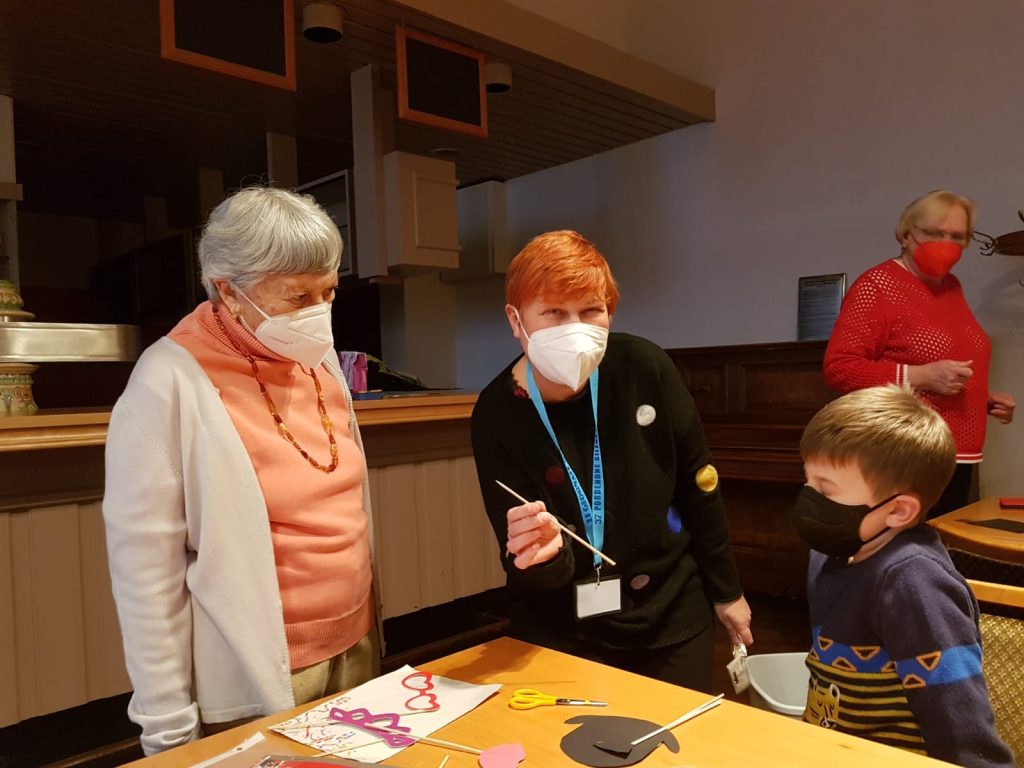
Handicrafts at the Charlie Chaplin Experience Day with Susanna Krauthauser (centre);
Photo: Maria Adorno
Repetitions:
As is well known, due to the pandemic situation, the admission of visitors was greatly reduced for all event halls. A maximum of 70 visitors were allowed in the Festhalle Durlach; in the cinema of the Kinemathek even less. We had decided to offer repeat programs for what are probably the best-attended programmes. Under normal conditions, we would have held two days of events in the Kinemathek cinema. Then, a few months before the festival, we had received the information that the conversion of the former cinema “Kurbel” by the jazz club would probably enter a decisive phase in January 2022, and that it could therefore happen that no event at all could take place in the cinema of the Cinematheque.
So we decided to only offer reruns in the cinematheque and to offer them only on one day. Its loss could have been tolerated without the festival program actually having to accept cuts.
An example of the complicated considerations this festival preparation required. To this day I don’t know whether the jazz club actually made any progress with the renovation. But that is another matter. …
We decided to repeat three events that actually took place parallel to the performances in the Festhalle Durlach.
We start at 3:00 p.m. in the cinematheque with the repetition of “The Marriage Circle”, this time accompanied by Gabriel Thibaudeau solo on the piano. Maria Adorno takes care of the event from our side and reports later that the event was well attended.
The other repetitions are then the program “The Alcoholic Slapstick” and as a third event “Tillie’s Punctured Romance”. While a halfway satisfactory number of visitors came to the “Alcoholic Slapstick”, the last performance was very poorly attended. That still surprises me to this day, because many of the visitors had bought tickets for both events at the “Alcoholic Slapstick”. We had been offered a special double feature ticket. The Sunday evening date turns out to be a bad date for events.
While I’m at the repeats, Maria Adorno is supervising the festival’s official closing event.
Closing event “The Z-Rays” (OT: I Raggi Z) and “College” by and with Buster Keaton
No festival with the theme “Comedy, Slapstick and Co.” without a film by and with Buster Keaton. At the 2020 festival, “The General” was one of the most successful films of the festival, which was certainly also due to the accompaniment by the “Capella Obscura”, our project orchestra, conducted by Cornelia Brugger. A commitment by the orchestra was out of the question due to the pandemic situation, because the whole situation was far too uncertain to start rehearsals with a large orchestra.
We decided to engage Gabriel Thibaudeau to accompany the program and also let him choose the film by and with Buster Keaton. From three of our suggestions, he chose “College”. Actually, it’s the sport or some particularly suitable sports that Buster Keaton uses a lot of funny ideas here. Occasionally it’s also slightly dangerous, as you can imagine – e.g. when throwing a discus.
Since “College” only lasts about 62 minutes, we are presenting an Italian comedy as a short film starring Gigetta Morano, who is unfortunately completely unknown in Germany. This was not always the case (see my comments below). Unfortunately, the film with the original title “I Raggi Z” is only preserved as a fragment and so we don’t find out what the rays are all about in the film (see also my comments on this). Incidentally, the German distribution title was actually “Die Z-Strahlen” (The Z-Rays). We know that, because amazingly, the film has only survived with the German titles.
Maria Adorno writes about the closing event: “On the last evening I had the pleasure of presenting the closing event in the Durlach Festhalle in person and took the opportunity to thank the audience who came despite the still difficult time of the pandemic; the technicians and staff of the festival for their excellent work; and of course the pianist of the last screening, Gabriel Thibaudeau, who accompanied the repeat of “The Marriage Circle” in the Kinemathek in Karlsruhe that afternoon. The audience came in large numbers and applauded heartily.
The first film of the evening was “The Z-Rays” (OT: I Raggi Z), a very special Italian film, especially as far as the well-written titles are concerned. Gabriel Thibaudeau had already accompanied this film at the Festival “Cinema Ritrovato” in Bologna in summer 2021 and, like us, was enthusiastic about this film. The audience was also infected by the special comicallness of the film. I myself saw the film for the first time and I was particularly pleased that the city of Turin was portrayed so well and creatively in the film (according to the first title in the film, it is actually set in Paris. …)
The next and last film was a great classic, “College”. There was much laughter from the audience and pleasant participation. Gabriel Thibaudeau’s music was obviously expert, almost every move of Keaton was accompanied very well by music and moments of suspense and comedy.
At the end of the closing event, I announced the dates for the 2023 festival and finally everyone chatted over champagne and pretzels and exchanged rich comments on the films of the evening and the festival in general.
Festival technicians and staff worked late into the night to dismantle everything. By midnight we were tired but very happy. And the festival was over.
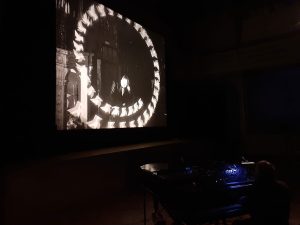
“I Raggi Z” (english title: “The Z-Rays”) in the Festhalle Karlsruhe-Durlach,
Photo: Maria Adorno
Notes on “I Raggi Z” (The Z-Rays)
As usual, the search for evidence of performances in the German-speaking area turned out to be more or less difficult. Thanks to the excellent digitization of the newspapers and magazines by the Austrian National Library, reviews and other documents are easy to find there.
The “Neue Kino-Rundschau” (Vienna) published the following short review in No. 118 of June 7, 1919:
“A well-known comedy interpreter who has become dear to all cinema-goers, the lovely Giggetta, lets the laughter in her five-act comedy hit “The Z-Rays” no longer catch one’s breath. Giggetta has also become dear to us through a number of smaller comedies, through “Mamsell Nitouche”. “The Z-Rays” will make her indispensable to us.”
We conclude: Gigetta Morano was well known to the public at the time; and the film received excellent reviews.
The text in the Neue Kino-Rundschau also states that the film was distributed by the company Wolframfilm GmbH, which had its headquarters in today’s Ústí nad Labem (Czech Republic), which was then called Aussig (a branch in Prague was planned).
It now seems quite possible that “The Z-Rays” was only distributed in the German-speaking areas that belonged to Austria-Hungary, whose days were numbered by that time. And so it is easy to explain that one of the few copies of the film is in the Czech film archive.
We have not yet found any evidence of showings in Germany – but that may also be due to the lamentably poor level of digitization of film magazines in rich Germany.
But what are the “Z-rays”? The review of a German film called “The Black Star” (OT: Der schwarze Stern” provides information about this, the director of which has been completely forgotten and whose main actor Hans von Mierendorff is probably only known to a few film scholars. In the magazine “Der Filmbote” (Vienna), No. 50 of December 16, 1922, there is the crucial information:
“The Black Star”,
an adventure film with Hans v. Mierendorff as Mac Allister, the inventor of the Z-rays, which have the power to span all distances and bring events to the eye and ear from the farthest away.”
That’s enough for us to guess who might be making use of the Z-rays in “I Raggi Z”: the very jealous wife of the delicatessen owner.
The further description of the content of the adventure film is so adventurous that I will include it here in the article “From the junk room of film history”.

On the left the owner of the delicatessen, on the right Gigetta Morano, and in the middle the jealous wife of the gentleman, presumably connected live (!) with the help of the Z-rays.
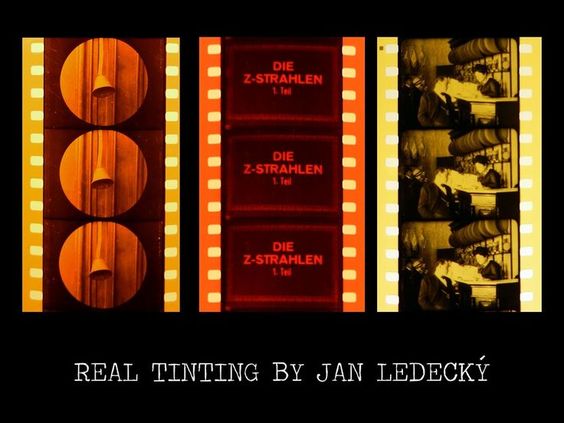
Like the photo above, this one is directly from the analog print; it can be clearly seen that it is a coloring of the carrier material. Both photos come from the website of the Museo Nazionale del Cinema, Turin.
Josef Jünger
